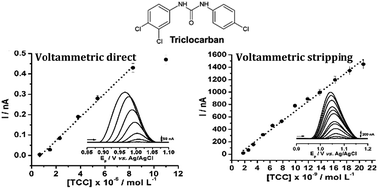Determination of triclocarban by direct and adsorptive stripping voltammetric methods on a glassy carbon electrode
Abstract
The first report of TCC electrochemical oxidation is presented aiming at its determination in personal care products and drinking water samples at trace levels, using square wave voltammetry (SWV) direct and adsorptive stripping modes. Electrochemical responses of TCC were evaluated using different voltammetric techniques over a wide pH range on a glassy carbon electrode (GCE), demonstrating irreversible and diffusion-controlled processes. The numbers of protons and electrons associated with the oxidation reactions were estimated. The most selective and sensitive response (acetate buffer, pH 5.4) was used for the development of SWV methods, under optimum conditions. A linear response range from (1.8–21) × 10−9 mol L−1 with a limit of detection (LOD) of 3.2 × 10−10 mol L−1, 1000 times lower than SWV direct mode, was obtained for SWV adsorptive stripping mode, including the acceptable levels of repeatability (rsd = 4.1%) and reproducibility (rsd = 5.4%) and has been applied to TCC determination in personal care products at levels ranging from 0.21 to 0.49 % m m−1 (average recovery of 95.3%) and drinking water (average apparent recovery of 95.4%) samples, with excellent analytical performance using simple and low cost instrumentation.


 Please wait while we load your content...
Please wait while we load your content...